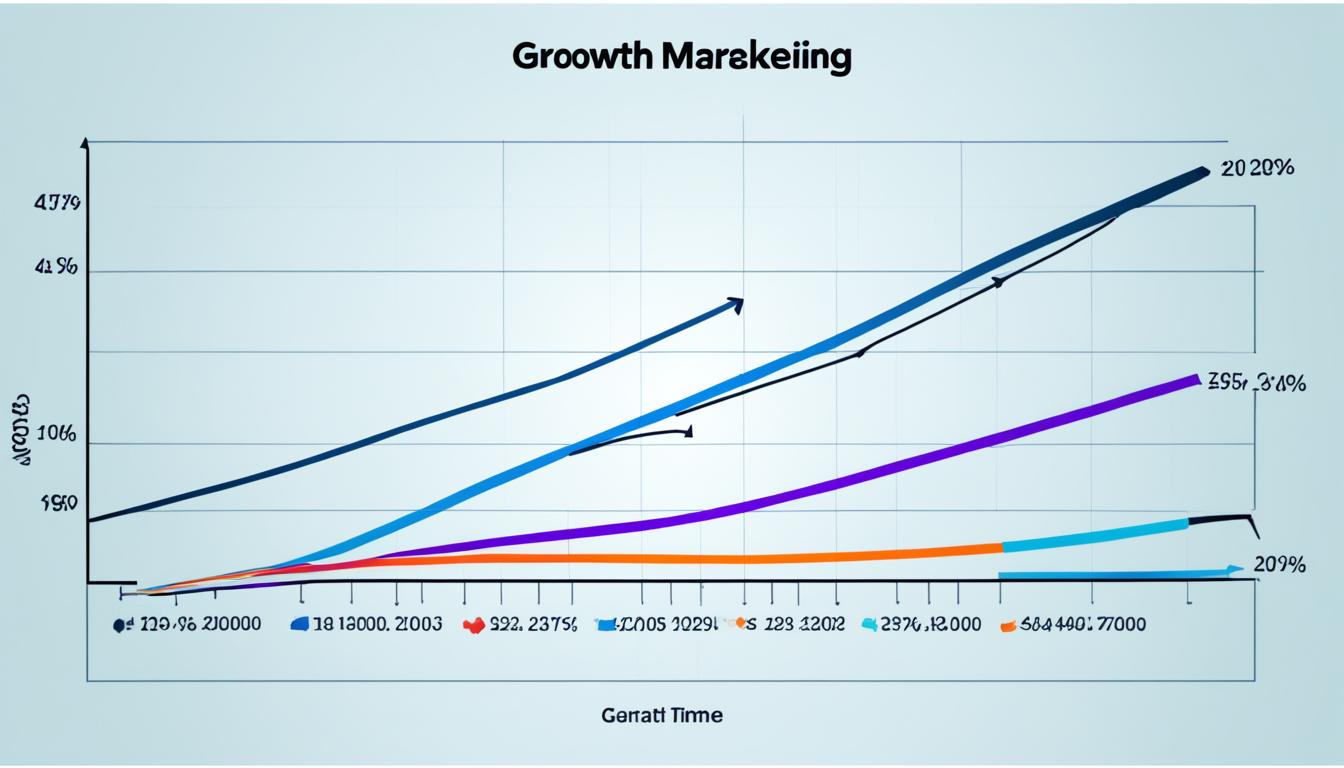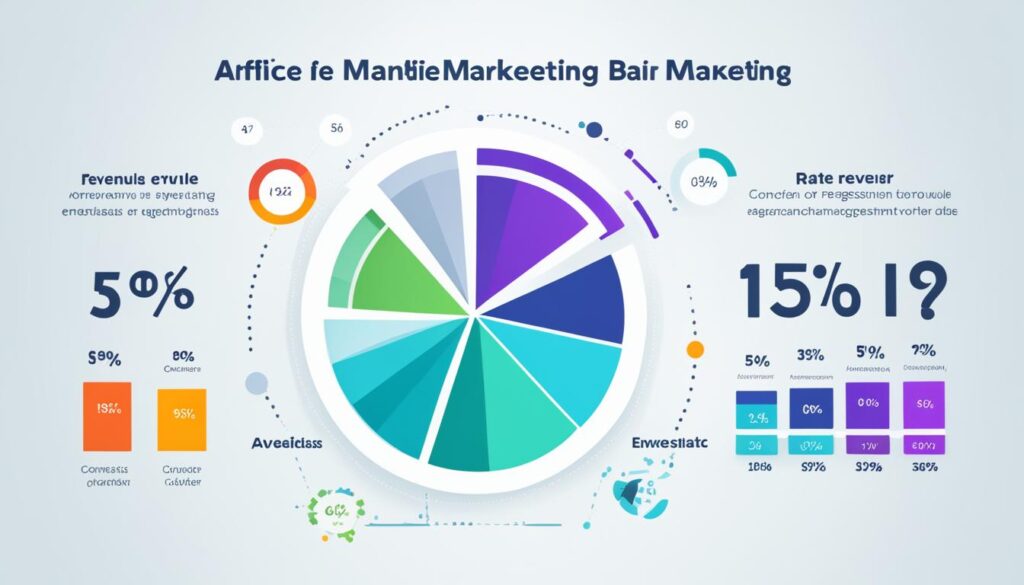
Affiliate marketing is set to hit $8.2 billion in sales by 2024. This big jump shows how powerful this form of marketing is. But to truly make the most of it, we must understand the numbers and data behind it.
This guide will dive into the key metrics of affiliate marketing. You’ll see how to use them to do better, earn more, and beat your rivals. From basic rates like click-through and conversion rates to figuring out earnings per click and ROI, you will grasp the essential numbers in this field.
Once you get a grip on these numbers, you’ll open new doors for success in affiliate marketing. It doesn’t matter if you’re new or have experience. This guide will give you the data and tools to grow smartly, driving success in the busy world of affiliate marketing.
Essential Affiliate Marketing Metrics
To succeed in affiliate marketing, you need to know certain metrics. The two most important ones are the click-through rate (CTR) and the conversion rate (CR). The CTR shows what percentage of people actually click your link from those who saw it.
It gives you insight into how well your content grabs people’s attention. By watching your CTR closely, you can adjust your strategies based on real data.
The conversion rate is even more important. It looks at how many people do what you wanted them to do after clicking, like buying something. Knowing your CR helps you understand if your marketing is actually turning visitors into buyers.
A high CR means you’re doing well. It shows your content and offers are meeting what people are looking for. This translates to more sales or sign-ups, making your affiliate program more profitable.
Both the CTR and CR are vital for measuring affiliate marketing performance. They together lay a strong base for evaluating how your marketing is working. This way, by mastering these rates and understanding how links perform, you can better your affiliate marketing. This will lead to more success in your marketing efforts.

Earnings Per Click (EPC)
Earnings Per Click (EPC) is key in affiliate marketing. It shows how much money each click on your links makes. Keeping an eye on your EPC helps understand which marketing campaigns are working. This way, you know where to spend your time and money.
A high EPC means your strategies are working well. You should focus on the partnerships that earn the most money. But if your EPC is low, it might be time to adjust your strategy. You could try making your content better or look for different affiliate programs.
Calculating your EPC is not hard. You just need to divide your total revenue by the clicks. This gives you a clear picture of how much you earn with each click. It helps you see the real impact of your marketing efforts.
Knowing and improving your EPC can boost your affiliate marketing. It’s important for both new and experienced marketers. By mastering your EPC, you increase the success and earnings of your program.
| Metric | Description | Formula |
|---|---|---|
| Earnings Per Click (EPC) | The average amount of revenue generated for each click on your affiliate links. | Total Affiliate Revenue / Total Clicks on Affiliate Links |
Advanced Affiliate Marketing Metrics
One key metric in the world of affiliate marketing is the return on investment (ROI). This measure tells you how profitable your efforts are. It shows the net gain or loss from your investments. By tracking your ROI closely, you can choose the best campaigns, products, or partnerships. This helps you use your resources wisely and earn more from affiliate marketing.
Customer Lifetime Value (CLV) is another important metric to know. It looks at the value of your long-term relationships through affiliate marketing. CLV shows the average revenue from each customer over time. Knowing your CLV helps in making smart choices for your affiliations and strategies. A high CLV signals loyal, high-value customers. It means your affiliate program is making a significant, positive impact. This knowledge lets you focus on the most profitable partnerships, enhancing the customer experience as you go.
Churn rate is vital, too, as it tracks how often customers or affiliates leave your program. High churn rates can show customer satisfaction or competitive problems. By watching your churn rate, you can spot areas to improve. For example, make the customer experience better, offer better products, or enhance your recruitment and retention. The goal is to keep the churn rate low to have a strong, lasting affiliate marketing ecosystem.
| Metric | Description | Importance |
|---|---|---|
| Affiliate Marketing ROI | Measures the net profit generated from your affiliate marketing investments. | Helps identify the most profitable campaigns, products, and partnerships, allowing for more effective resource allocation. |
| Customer Lifetime Value (CLV) | Determines the average revenue generated from each customer over the course of their relationship with your brand. | Enables strategic decision-making about affiliate partnerships and marketing strategies, focusing on the most valuable customer relationships. |
| Churn Rate | Measures the rate at which customers or affiliates stop engaging with your program over a specific period. | Identifies areas for improvement in the affiliate program, such as enhancing the customer experience or strengthening retention strategies, to maintain a thriving and sustainable ecosystem. |
Others also read this article : Make Money Online Without Investment: Easy Ways
Understanding Affiliate Marketing Metrics and Analytics
Getting good at using affiliate marketing data is key. It’s important for long-term success. Understanding affiliate marketing metrics helps you make smart data-driven decisions. This lets you optimize affiliate marketing campaigns using analytics. You’ll learn about click-through rates, conversion rates, earnings per click, and more in this detailed guide.
Start using the power of data and see your marketing success grow. Learn from these metrics to make your campaigns better. Use all the information you have to refine your strategies and stay ahead.
Interpreting affiliate marketing metrics helps you see trends and find areas to improve. It guides you to make changes that bring great results. Using analytics to optimize affiliate marketing campaigns leads to long-term growth and success.
Dive into the world of affiliate marketing metrics and analytics. This journey is all about getting better and more innovative. Reap the rewards of a data-focused approach in your affiliate marketing efforts. Turn your story into a true success story.
Tools and Platforms for Tracking Affiliate Marketing Metrics
To really succeed in affiliate marketing, you need strong tools. These tools should show you lots of info and help make smart choices. There are two main tools for this: Google Analytics and specific affiliate tracking software.
Google Analytics is packed with tools for tracking important stuff in affiliate marketing. You can see where your traffic comes from, who buys, what campaigns work best, and more. Connecting your affiliate links to Google Analytics lets you really know your crowd. Plus, it shows you how well your ads and promos do.
Then, there’s the affiliate tracking platforms. These offer super detailed link management, tracking your earnings, and reporting your success. They also watch out for affiliate fraud. With these, you can see results instantly, calculate earnings automatically, and set up your own custom info screens. That way, you can choose the best moves to hit your affiliate marketing goals.
| Metric | Google Analytics | Affiliate Tracking Software |
|---|---|---|
| Traffic Sources | ✓ | ✓ |
| Conversions | ✓ | ✓ |
| E-commerce Performance | ✓ | ✓ |
| Campaign-level Data | ✓ | ✓ |
| Link Management | Limited | ✓ |
| Commission Tracking | Limited | ✓ |
| Performance Reporting | Limited | ✓ |
| Fraud Detection | Limited | ✓ |
Using these affiliate marketing tracking tools and platforms can help you understand your marketing better. They help you make choices based on good data to reach your goals.
Interpreting Affiliate Marketing Metrics for Optimization
Affiliate marketing metrics are powerful. They guide continuous optimization. By looking closely at clicks, conversion rates, earnings per click (EPC), and revenue per mille (RPM), you find areas to improve. Then, you make changes to boost your affiliate marketing efforts.
You might adjust your targeting. Or, work on your content and calls-to-action. You could even try different ad placements. This data helps you make smart choices in your marketing. By using a data-driven approach to optimizing, your affiliate marketing performance can improve steadily. This leads to growth that lasts.
| Metric | Interpretation | Impact on Optimization |
|---|---|---|
| Clicks | Shows how much attention your affiliate offerings get. | Look at click patterns to better target your audience. This helps improve your strategies. |
| Conversion Rate | Measures how well your campaigns get the actions you want, like sales or leads. | Find the best affiliates, offers, and channels using these metrics. This makes your marketing better. |
| EPC | Figures out how much money each click earns. This shows how well your program does. | Adjust commissions and marketing materials using this data. It helps improve your campaigns. |
| RPM | Looks at revenue for every 1,000 views. It shows how well your strategy works overall. | Tweak ads, content, and targeting to do better in clicks, EPC, and RPM. This improves your results. |
By using data to optimize your strategies, you fully unlock your affiliate marketing’s potential. This leads to growth that continues over time.
Maximizing Performance with Clicks, EPC, and RPM
Understanding affiliate marketing requires knowing how clicks and conversions, earnings per click (EPC), and revenue per mille (RPM) work together. Clicks show when people first get interested. EPC measures how much money this might bring in. RPM looks at earnings for every thousand views.
By studying these metrics, we see the whole audience journey. This starts with first interest and possibly ends with a purchase. With this info, we can adjust our plans and make more money.
Tracking clicks and conversions helps us see what content or ads people like. Knowing what attracts your audience means you can focus on that. This can lead to more clicks and potential sales.
Looking at earnings per click (EPC) tells us the revenue potential from each click. We can see which products or ads make the most money. Then, change our plan to promote those better.
Focusing on revenue per mille (RPM) gives a bigger picture of earnings. This can show where we can do better. Using this, we can plan to make our ads or campaigns more effective over time.
By learning how clicks and conversions, EPC, and RPM work, we can do better in affiliate marketing. Keep learning from your data. Always adjust your strategy to stay successful in this exciting field.
Others also read this article : Couples: Discover Ways to Make Money Online Together
The Power of Continuous Optimization
The magic of affiliate marketing is in continuous optimization. You track and analyze key metrics regularly. This helps to find areas that need work and make your affiliate marketing efforts more effective.
This approach involves often refining your strategies. It means adjusting your targeting, content, and ad placements. Data-driven decisions are crucial for growth.
Using an iterative optimization approach in affiliate marketing can lead to big successes. You keep adapting and improving from what you learn in your metrics. Enhancing performance over time takes effort but it’s worth it.
Stay quick to change and ready to use new data wisely. This is how you find chances for small, but important, improvements. Always test, analyze, and adjust to do better and better.
To master affiliate marketing, rely on smart data and keep optimizing. This mindset takes your campaigns to great success.
Conclusion
In affiliate marketing, knowing your numbers is key to winning. You must understand metrics like click-through rate and conversion rate. Also, dig into advanced stats like return on investment for deep insights.
Using the right tracking tools is vital. They help you see your audience’s path clearly. Armed with this info, you can drive continuous growth. This approach leads to mastering data and analytics. It secures your success over time.
The core key takeaways for mastering affiliate marketing data are valuable. They highlight the role of data-driven decision making in affiliate marketing. This understanding sets you up for big success in this lively sector.





